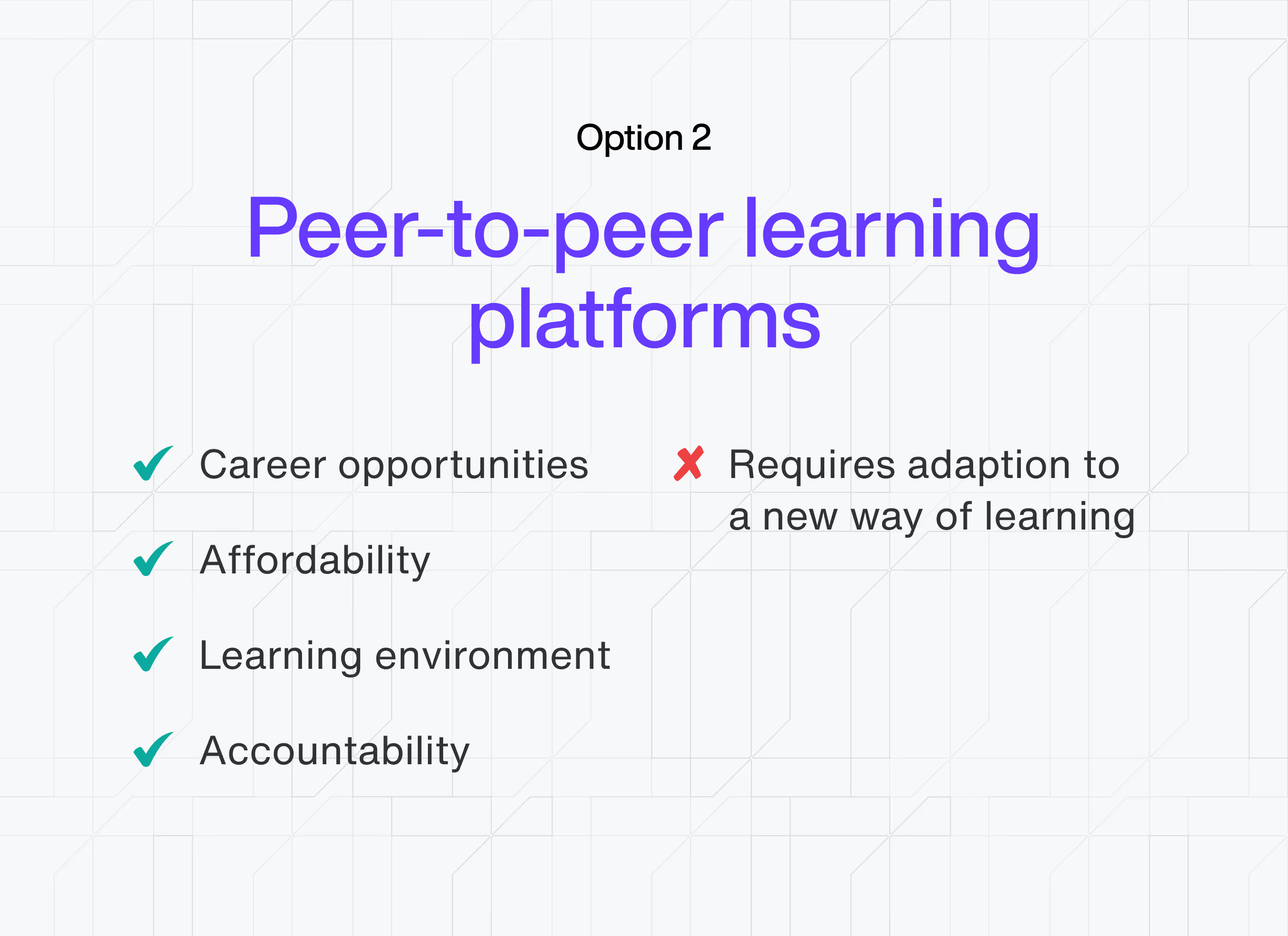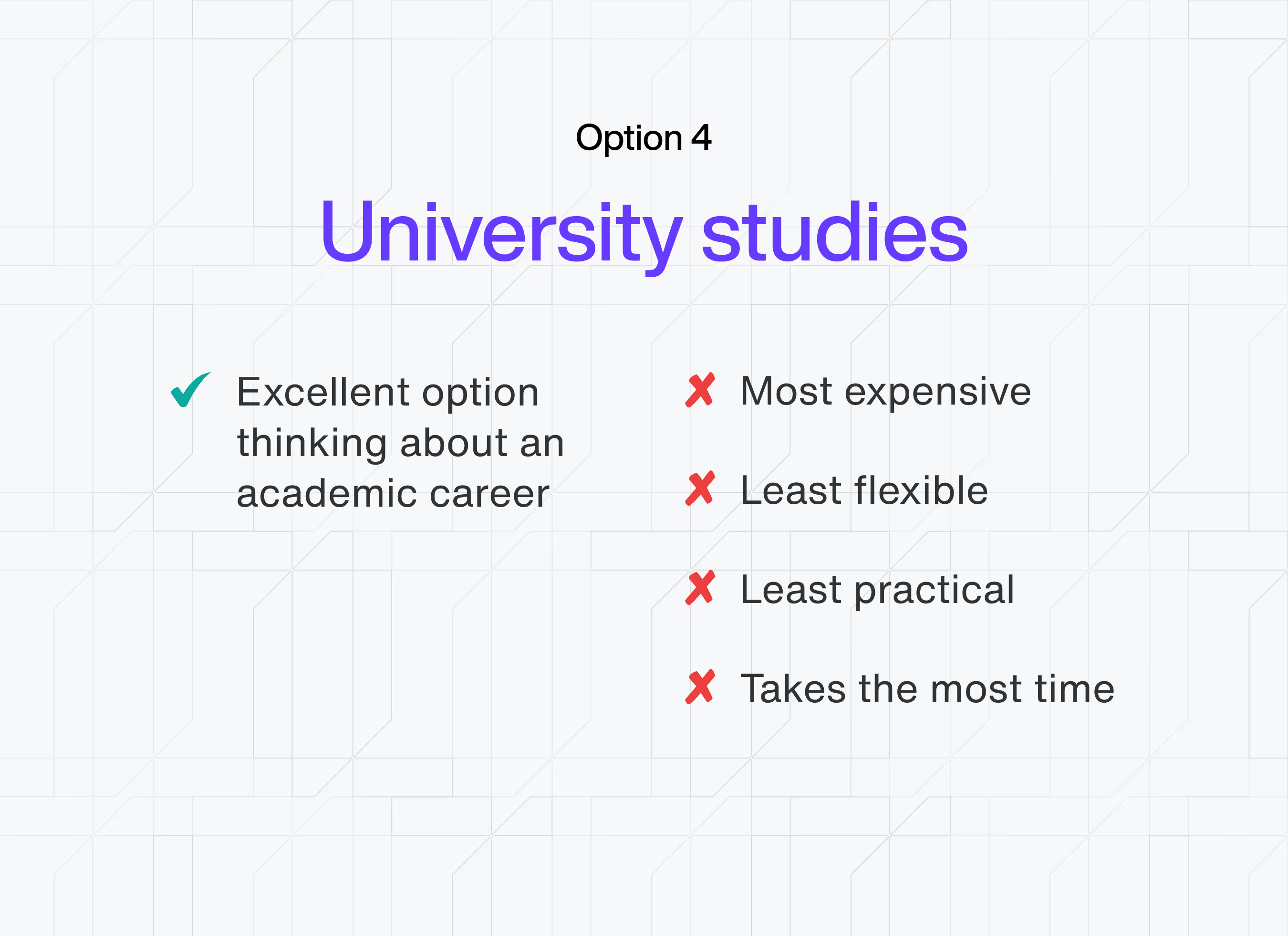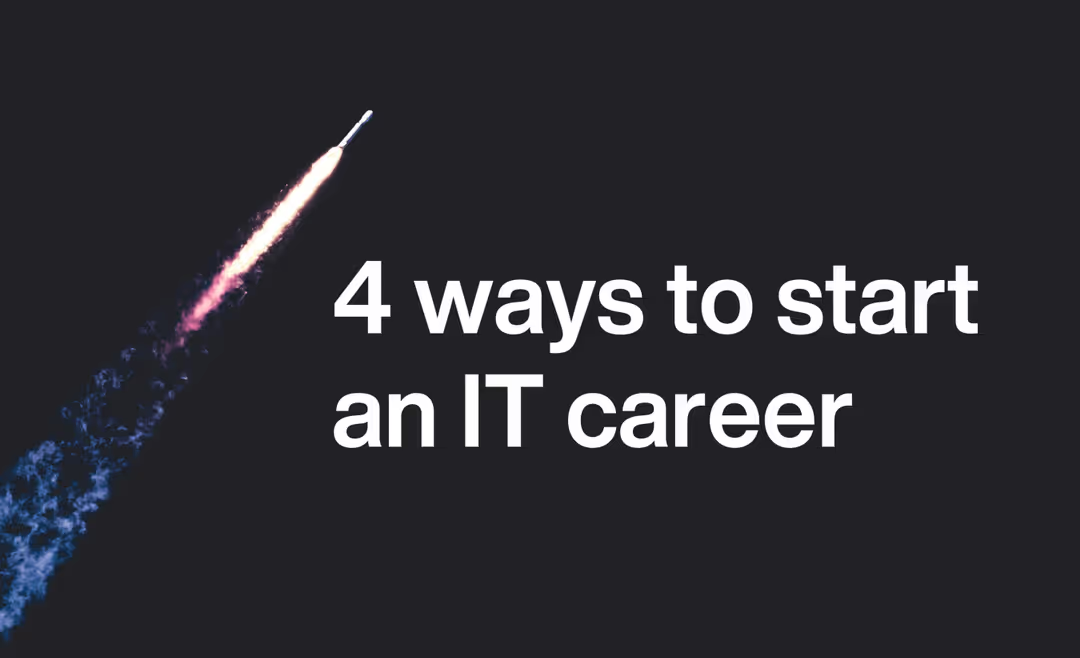How to change careers in today's unpredictable jobs market? Before you start thinking about specific programs or institutions, you need to understand the different options you have for switching to a career in IT.
In this article, we'll take you through the main strengths and weaknesses of:
- learning on your own with MOOC courses,
- joining a peer-to-peer remote learning course,
- attending a bootcamp,
- or completing postgraduate studies at a university.
Once we've gone through each option, you'll be in a better place to decide which route is the best way for you to start your IT career.
Option 1: Learn by Yourself With MOOC Courses
What could be simpler? Just sign up to a coding or Data Science course online and learn everything yourself. Actually, it's not quite as simple as it sounds, though there are some clear advantages to online, self-paced learning. Let's consider the main pros and cons of teaching yourself online as a way to shift career.

Key Advantages of MOOC Courses
The obvious advantages of self-paced online learning are the flexibility and lack of cost. If you're studying or working, the fact that you can choose when to watch lectures or submit projects can be a big help.
In terms of cost, there are plenty of good options that are completely free. For example, you can access all of the materials from Harvard's data science course online for free. This will take you through a semester's worth of learning, with 24 lectures in total. The Harvard course you study is from 2015, so it's not exactly cutting edge. But it should serve well as an introduction to Data Science. Along with the Harvard course, this Forbes article on the best free online Data Science courses takes you through the best available options in 2020.
Key Disadvantages of MOOC Courses
In a sense, the advantages of online courses are also the disadvantages.
Firstly, there's the cost. The fact that these courses are free or low cost means you miss out on one of the vital components in learning - feedback from experienced professionals. Not only does this mean your mistakes go uncorrected, it also impacts your career possibilities.
Telling an employer that you have completed an online course doesn't give them much insight as to your actual level of competence. Even if you completed a test or graded assignment at the end of the course, all this means is you've learned the material to pass the course. Your ability to apply this knowledge in real life scenarios remains untested. With many free online courses, you won't get a diploma or any way of showing what level of competence you have reached.
Then there's the flexibility. It sounds great, but without sufficient structure it can actually be a real problem. Without peers, supervisors or looming deadlines to encourage you, ask yourself how you will stay motivated to complete your studies? Learning IT or Data Science isn't always going to be easy. And without structure, it all comes down to your will power. Sure, for the first couple of weeks you'll be full of energy and focus. But when the weeks turn into months, how easily will it be for you to put the time in?
MOOC IT and Data Science Courses: The Verdict
The things that make online, self-paced learning attractive (the lack of deadlines, the flexibility, the low costs) are also the things that make it ineffective. Without clear structure, peers or tutors, or the simple fact that you've paid for your studies to push you forward, you'll need to constantly motivate yourself. This takes a lot of energy. And if you are successful, there's no guarantee that you'll have learned the skills real IT companies are looking for. And even if you have, how do you prove it?
If you're interested in coding or data science as a new hobby, go ahead and do some self learning online. But in terms of changing careers, there are better options available.
Option 2: Peer-to-Peer Learning Platforms
Peer-to-peer learning platforms are a new breed of IT course. In these courses, you join a cohort of fellow learners and progress through a series of projects at your own pace, but with support and feedback from your peers and experienced IT professionals.

Key Advantages of Peer-to-Peer Learning Platforms
There are a lot of major advantages peer-to-peer learning platforms have to offer, but we'll try to be brief. Let's break these advantages down into 3 main areas: career opportunities, cost, and learning environment.
Career opportunities: The most advanced peer-to-peer learning platforms work directly with tech companies to both formulate the curriculum and coordinate hiring on graduation. With these schools, instead of a diploma you simply get a job. So there's no need to worry about whether your qualifications will be taken seriously - if you can get onto a course and complete it, you're basically guaranteed a job.
Affordability: There are peer-to-peer learning platforms that offer income share agreements, or ISAs. These are contracts between you and the school where they pay for your tuition while you learn, then you pay them back. The smart part is you only have to pay them back once you've secured a top-earning job in IT. It's even possible to get future employers to cover some or all of your ISA. With no upfront costs, this is a really affordable way to shift to a career in IT.
Learning environment: Unlike studying by yourself, with these colleges and schools you become part of a community. You start your studies at the same time as other learners, review their work (and they'll review yours), work together on projects, and take part in social events. You also get support and feedback from experienced professionals, plus career guidance. This will help you develop those all important soft skills that IT employers are looking for.

This new and exciting model of IT education gives you flexibility - with no fixed lectures or specific project deadlines you can learn at your own pace. But you also get support and encouragement, so you don't need to rely solely on your will power for the motivation to succeed.
Key Disadvantages of Peer-to-Peer Learning Platforms
You'll have to adapt to a new way of learning, especially if you're used to a university type structure. With no formal classes and less defined deadlines, a lot more depends on you to guide your own learning. This may suit many learners, but for some it can be a bit of a steep learning curve. The fix for this is to choose a platform that offers a trial month, where you can give it a go but you don't lose anything if you decide it's not for you.
Peer-to-Peer Learning Platforms for IT and Data Science: The Verdict
These platforms combine the benefits of self-learning (affordability and flexibility) with the advantages of traditional courses (regular feedback, a structured learning environment, and credible proof of your level that employers will trust). They are definitely worth a try, and if you find a platform offering trial months you have nothing to lose.
Option 3: Bootcamps for IT and Data Science
IT and data science coding bootcamps have become popular alternatives to university or college education. The short, intensive courses bootcamps provide can provide a way to transition into a career in IT.

Key Advantages of IT and Data Science Bootcamps
There are two ways to think about the advantages bootcamps have to offer - comparing them to studying alone, and comparing them to studying at a university.
So, compared to learning by yourself, bootcamps have the obvious advantage of providing supervision from experienced tutors. This means you receive specific feedback on areas of individual strength and weakness, helping you to improve as an IT specialist. The involvement of professionals also gives bootcamps more credibility, so the qualification you acquire is more likely to be taken seriously by a potential employer (though this is by no means guaranteed).
And compared to studying at a university, the obvious advantage of a bootcamp is the amount of time required to complete a course. While a Masters degree will most likely take you 2 years or more to complete, global data on bootcamps in 2021 shows the average bootcamp takes 14 weeks to complete. So, if your mentality is "I want to change my career now", bootcamps are a better option than universities.
Key Disadvantages of IT and Data Science Bootcamps
The experience with bootcamps can be really hit and miss - there are a lot of them out there now and you've really got to do your homework before choosing one.
Some of the main disadvantages to look out for are high costs, low flexibility, and limited appeal to employers. Let's take a quick look at each of these problems.
In terms of cost, bootcamps are an expensive option. Prices for the best known bootcamps in Europe range from €4,000 to €9,000 per course. The average cost for a bootcamp in the US is an eye-watering $13,500. This is a lot to pay out for 14 weeks of education (on average), and you want to make sure your course delivers when it comes to furthering your career, which leads us on to our second disadvantage.
Bootcamps don't always train you up in what employers are actually looking for. This is especially true when looking at soft skills. Sure, you'll probably learn at least the basic technical skills required. But employers get little to no idea of how good you are at using these skills on real projects as part of a team. As a result, according to recent analysis of career options from bootcamps in the US, "job placement rates aren't great" and "a coding bootcamp doesn't guarantee gainful employment."
A final problem to consider is the lack of flexibility. With bootcamps, learning moves at one speed. If you're a fast learner, you'll have to wait for others. And if you want to take your time on a particular topic, you'll be hurried along. You'll also have fixed contact hours which may not fit with other work or study commitments. While remote only bootcamps may offer a bit more flexibility, they still can't compete with peer-to-peer platforms or self learning.
Bootcamps for IT and Data Science: The Verdict
Bootcamps are definitely a step up from learning online by yourself as you get the support of real specialists in IT. And they offer a more attractive option than universities in terms of duration and (perhaps) cost. But this remains an expensive option, and you have to be extra careful that you will gain the actual skills employers are looking for. In summary, this is a viable but risky way to shift to a career in IT or data science.
Option 4: University Studies
The final option is the least viable and attractive, so here we'll address the pros and cons a little bit quicker.

Of course, university studies can be a lot of fun, and if you're fortunate enough to get into a prestigious university then you'll certainly benefit from the name on top of your diploma.
But this is an article about changing to a career in IT. And for this purpose, it's pretty clear that postgraduate studies at a university aren't a great option. Here's why.
- It's the most expensive: If the prices for bootcamps looked high, the cost of good quality university education is even higher in the US and Europe.
- It's the least flexible: With a few exceptions, universities have been slow to embrace the online revolution in education. Courses are rigid in terms of pacing and contact hours.
- It's the least practical: University studies focus a lot more on theory than bootcamps or peer-to-peer learning platforms. As a result, you're less likely to gain the real-life skills needed by employers.
- It takes the most time: While peer-to-peer platforms and bootcamps can get your career transformed in 6 to 9 months, with universities you'll be looking at 2 years or more.
Naturally, university education is an excellent option if you're seriously thinking about an academic career as a researcher. But if your goal is to shift careers with sacrificing lots of your time and money, this isn't really an option.
How to Change Careers: You Decide
Hopefully, this article has given you some food for thought when it comes to retraining for a career in IT. Every option has its strengths and weaknesses. But choosing between bootcamps, universities, MOOC or peer-to-peer platforms is the first decision you'll have to make.
Once you know which way you want to go, there are plenty of options. You can choose a data analyst career path, a data scientist career path, or a more general career in IT. If you're interested in data science in particular, check out this breakdown of career paths and jobs in data science.
As the saying goes, carpe diem - there's never been a better time to change your career.
